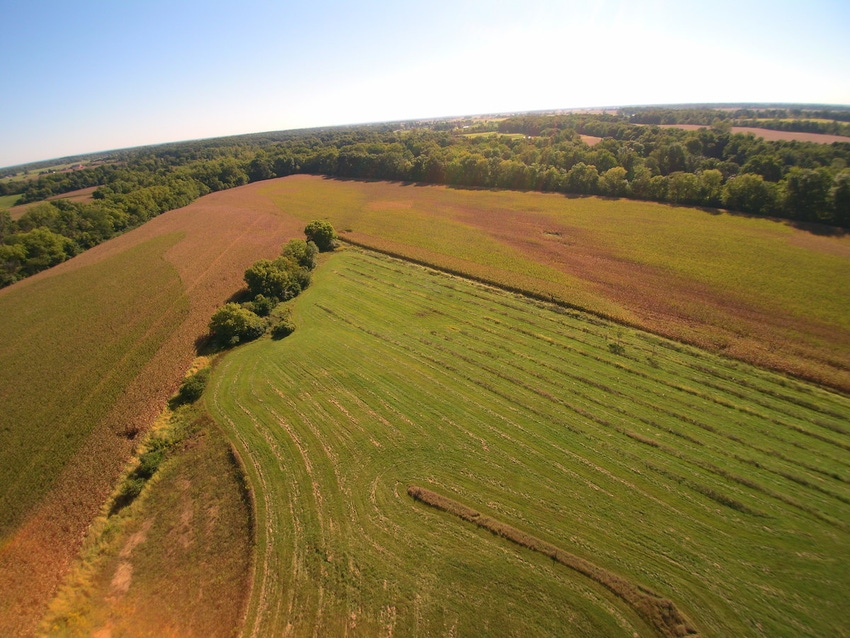January 29, 2016

After watching research on multi-hybrid corn planting for several years, Jim Case decided the time was right in 2015 to replace his 11-year-old planter and begin to take advantage of extra yield potential with a new planter.
Although an unusually wet spring led to less-than-ideal-growing conditions on his Delaware, Ohio, farm, Case says the new multi-hybrid planting system proved that planting both offensive and defensive hybrids in the same fields is a money-maker.
“We had about a 13 bushel/acre yield advantage,” says Case. “Over 600 acres, that nearly pays for the cost of adding the multi-hybrid option to the planter in the first year. “Maybe somebody with more uniform soil types wouldn’t see the advantage, but our fields are all over the board. They are rolling, with five to seven soil types in some of them.”
The multi-hybrid upgrade added about $30,000 to the price of his planter – a 16-row unit from Kinze. That’s about the same cost per row as adding multi-hybrid capabilities to a planter using row units from Precision Planting, the other major option.
Match offense, defense hybrids
Case's foray into multi-hybrid planting was a scramble, from purchasing the planter over winter, to learning how to operate it during a trip to Texas in April, to selecting corn hybrids to pair up in his fields.
“Everybody was sweating bullets to make sure everything came together,” he says.
Besides getting the planter up and running, selecting the right hybrids was the most critical task. Case and several precision farming, agronomy, seed sales and other specialists from Beck’s Hybrids worked together to hammer out the best options for his fields. They eventually selected two sets of matching-maturity offensive/defensive hybrid pairs, with different maturities to spread out harvest.
Offensive corn hybrids were chosen from among hybrids that perform well in highly productive environments, but with performance that falls off in low-productivity areas or stressful conditions. Defensive hybrids were selected for their ability to perform well under stress, although they tend to underperform in high-yield environments.
Case and his seed advisers used normalized yields from four years to delineate where to place the offensive and defensive hybrids. “It’s important to have multiple years to evaluate areas that produce consistently high yields and areas that consistently struggle,” says Mike Hannewald, a Beck’s precision farming specialist.
| Download this article in .PDF format |
One of the biggest questions was which of the hybrids to plant in the middle ground between low- and high-productivity areas. In fields with the best overall yield potential, Case opted to plant offensive hybrids in the middle ground. In fields with lower average potential, the defensive hybrid got the middle-ground nod.
“They know their hybrids a lot better than I do,” says Case. “We know our ground a lot better than they do. Working together, we made some good decisions.”
Automatic test plots
Case relied on two 1- to 2-acre in-field test plots in each field to evaluate how well the multi-hybrid system worked. The test plots involved planting the offensive hybrid in the defensive area, and the defensive hybrid in the offensive area. The plots were built into the planting prescription, so the test plots didn’t require extra labor.
“Being able to plant test plots automatically on the fly is a huge asset,” says Case. “It worked flawlessly.”
However, wet spring and early summer weather ruined the plots in all but five fields. In the five fields where the test plots thrived, the defensive hybrid out-yielded the offensive hybrid by 14.1 bushels/acre in low-productivity areas. In high-productivity areas, the offensive hybrid was up 12.1 bushels/acre compared to the defensive hybrid, for an average yield increase of 13.1 bushels/acre for the multi-hybrid pairs. That compares to a three-year average yield increase of 7.9 bushels/acre for multi-hybrid planting in Beck’s trials from 2012-2014.
| Download this article in .PDF format |
Even though test plots weren’t available in all his fields, Case is confident that the multi-hybrid system performed well across his operation. He notes that in 23 of 24 fields he planted, the offensive hybrid outperformed the defensive hybrid, a positive sign that overall yield was up. That’s in contrast to past multi-hybrid research, which has shown that defensive hybrids can out-perform offensive hybrids when excessive rainfall stresses offensive hybrids and enables defensive hybrids to shine.
Rethink management systems
Case sees opportunities to improve hybrid selection, but doesn’t expect to make big changes in 2016.
“We will look a little bit closer at plant populations and varieties,” he says. “We may look at fine-tuning a few of the zones.”
Hannewald says working with Case in 2015 taught him two key lessons. First, multi-hybrid planting is a learning process, with performance gains likely to improve with experience. Second, multi-hybrid planting requires rethinking management systems. “Multi-hybrid planting is a different way of managing, from ordering your seed to logistics in the field, including a seed tender that can handle two hybrids,” he says.
About the Author(s)
You May Also Like







